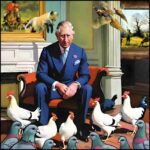British King Charles III adopts hens, quits pigeon racing
” data-image-caption=”
(Beth Clifton collage)
” data-medium-file=”https://i0.wp.com/www.animals24-7.org/wp-content/uploads/Picsart_24-08-25_16-01-12-899-e1724626901547.jpg?fit=300%2C300&ssl=1″ data-large-file=”https://i0.wp.com/www.animals24-7.org/wp-content/uploads/Picsart_24-08-25_16-01-12-899-e1724626901547.jpg?fit=1024%2C1024&ssl=1″ tabindex=”0″ role=”button” class=” wp-image-67618 lazyload” src=”https://www.animals24-7.org/wp-content/uploads/Picsart_24-08-25_16-01-12-899-e1724626901547.jpg” alt=”Prince Charles and animals.” width=”344″ height=”344″>
![]()
” data-image-caption=”
(Beth Clifton collage)
” data-medium-file=”https://i0.wp.com/www.animals24-7.org/wp-content/uploads/Picsart_24-08-25_16-01-12-899-e1724626901547.jpg?fit=300%2C300&ssl=1″ data-large-file=”https://i0.wp.com/www.animals24-7.org/wp-content/uploads/Picsart_24-08-25_16-01-12-899-e1724626901547.jpg?fit=1024%2C1024&ssl=1″ tabindex=”0″ role=”button” class=” wp-image-67618 lazyload” src=”https://i0.wp.com/www.animals24-7.org/wp-content/uploads/Picsart_24-08-25_16-01-12-899-e1724626901547.jpg?resize=344%2C344&ssl=1″ alt=”Prince Charles and animals.” width=”344″ height=”344″ data-recalc-dims=”1″>
(Beth Clifton collage)

 </p>
<p>” data-medium-file=”https://i0.wp.com/www.animals24-7.org/wp-content/uploads/Picsart_24-06-09_15-19-41-868-scaled-e1724624563837.jpg?fit=226%2C300&ssl=1″ data-large-file=”https://i0.wp.com/www.animals24-7.org/wp-content/uploads/Picsart_24-06-09_15-19-41-868-scaled-e1724624563837.jpg?fit=771%2C1024&ssl=1″ tabindex=”0″ role=”button” class=”wp-image-65826 lazyload” src=”https://www.animals24-7.org/wp-content/uploads/Picsart_24-06-09_15-19-41-868-scaled-e1724624563837.jpg” alt=”Arabella the hen.Arabella the specked Sussex hen. (Beth Clifton photo)” width=”292″ height=”388″></p>
<p id=)
 </p>
<p>” data-medium-file=”https://i0.wp.com/www.animals24-7.org/wp-content/uploads/Picsart_24-06-09_15-19-41-868-scaled-e1724624563837.jpg?fit=226%2C300&ssl=1″ data-large-file=”https://i0.wp.com/www.animals24-7.org/wp-content/uploads/Picsart_24-06-09_15-19-41-868-scaled-e1724624563837.jpg?fit=771%2C1024&ssl=1″ tabindex=”0″ role=”button” class=”wp-image-65826 lazyload” src=”https://i0.wp.com/www.animals24-7.org/wp-content/uploads/Picsart_24-06-09_15-19-41-868-scaled-e1724624563837.jpg?resize=292%2C388&ssl=1″ alt=”Arabella the hen.Arabella the specked Sussex hen. (Beth Clifton photo)” width=”292″ height=”388″ srcset=”https://i0.wp.com/www.animals24-7.org/wp-content/uploads/Picsart_24-06-09_15-19-41-868-scaled-e1724624563837.jpg?w=800&ssl=1 800w, https://i0.wp.com/www.animals24-7.org/wp-content/uploads/Picsart_24-06-09_15-19-41-868-scaled-e1724624563837.jpg?resize=226%2C300&ssl=1 226w, https://i0.wp.com/www.animals24-7.org/wp-content/uploads/Picsart_24-06-09_15-19-41-868-scaled-e1724624563837.jpg?resize=771%2C1024&ssl=1 771w, https://i0.wp.com/www.animals24-7.org/wp-content/uploads/Picsart_24-06-09_15-19-41-868-scaled-e1724624563837.jpg?resize=768%2C1020&ssl=1 768w” sizes=”(max-width: 292px) 100vw, 292px” data-recalc-dims=”1″></p>
<p></a> <em><strong>(Beth Clifton photo) </strong></em></div>
<h2 style=) “Special milestone for the British Hen Welfare Trust”
“Special milestone for the British Hen Welfare Trust”
 </p>
<p>” data-medium-file=”https://i0.wp.com/www.animals24-7.org/wp-content/uploads/PicsArt_09-28-08.25.09-scaled-e1633063785618.jpg?fit=232%2C300&ssl=1″ data-large-file=”https://i0.wp.com/www.animals24-7.org/wp-content/uploads/PicsArt_09-28-08.25.09-scaled-e1633063785618.jpg?fit=792%2C1024&ssl=1″ tabindex=”0″ role=”button” class=”size-full wp-image-45193 lazyload” src=”https://www.animals24-7.org/wp-content/uploads/PicsArt_09-28-08.25.09-scaled-e1633063785618.jpg” alt=”Hens chickens” width=”350″ height=”453″></p>
<p id=)
 </p>
<p>” data-medium-file=”https://i0.wp.com/www.animals24-7.org/wp-content/uploads/PicsArt_09-28-08.25.09-scaled-e1633063785618.jpg?fit=232%2C300&ssl=1″ data-large-file=”https://i0.wp.com/www.animals24-7.org/wp-content/uploads/PicsArt_09-28-08.25.09-scaled-e1633063785618.jpg?fit=792%2C1024&ssl=1″ tabindex=”0″ role=”button” class=”size-full wp-image-45193 lazyload” src=”https://i0.wp.com/www.animals24-7.org/wp-content/uploads/PicsArt_09-28-08.25.09-scaled-e1633063785618.jpg?resize=350%2C453&ssl=1″ alt=”Hens chickens” width=”350″ height=”453″ data-recalc-dims=”1″></p>
<p></a> <em><strong>(Beth Clifton photo)</strong></em></div>
<h2 style=) “One hen had a stance like a penguin”
“One hen had a stance like a penguin”
</p>
<p>” data-medium-file=”https://i0.wp.com/www.animals24-7.org/wp-content/uploads/Jane-Howorth-Founder-of-the-British-Hen-Welfare-Trust-300×201.jpg?fit=213%2C201&ssl=1″ data-large-file=”https://i0.wp.com/www.animals24-7.org/wp-content/uploads/Jane-Howorth-Founder-of-the-British-Hen-Welfare-Trust-300×201.jpg?fit=213%2C201&ssl=1″ tabindex=”0″ role=”button” class=” wp-image-8602 lazyload” src=”https://www.animals24-7.org/wp-content/uploads/Jane-Howorth-Founder-of-the-British-Hen-Welfare-Trust-300×201.jpg” alt=”” width=”297″ height=”281″></p>
<p id=)
</p>
<p>” data-medium-file=”https://i0.wp.com/www.animals24-7.org/wp-content/uploads/Jane-Howorth-Founder-of-the-British-Hen-Welfare-Trust-300×201.jpg?fit=213%2C201&ssl=1″ data-large-file=”https://i0.wp.com/www.animals24-7.org/wp-content/uploads/Jane-Howorth-Founder-of-the-British-Hen-Welfare-Trust-300×201.jpg?fit=213%2C201&ssl=1″ tabindex=”0″ role=”button” class=” wp-image-8602 lazyload” src=”https://i0.wp.com/www.animals24-7.org/wp-content/uploads/Jane-Howorth-Founder-of-the-British-Hen-Welfare-Trust-300×201.jpg?resize=297%2C281&ssl=1″ alt=”” width=”297″ height=”281″ data-recalc-dims=”1″></p>
<p></a> <em><strong>Jane Howorth & hen.</strong></em><br /><em><strong>(British Hen Welfare Trust photo)</strong></em></div>
<h2 style=) Royal recognition
Royal recognition
 </p>
<p>” data-medium-file=”https://i0.wp.com/www.animals24-7.org/wp-content/uploads/Prince-Charles-with-kazooo.jpg?fit=289%2C300&ssl=1″ data-large-file=”https://i0.wp.com/www.animals24-7.org/wp-content/uploads/Prince-Charles-with-kazooo.jpg?fit=986%2C1024&ssl=1″ tabindex=”0″ role=”button” class=” wp-image-32769 lazyload” src=”https://www.animals24-7.org/wp-content/uploads/Prince-Charles-with-kazooo.jpg” alt=”Prince Charles with Kazoo” width=”342″ height=”355″></p>
<p id=)
 </p>
<p>” data-medium-file=”https://i0.wp.com/www.animals24-7.org/wp-content/uploads/Prince-Charles-with-kazooo.jpg?fit=289%2C300&ssl=1″ data-large-file=”https://i0.wp.com/www.animals24-7.org/wp-content/uploads/Prince-Charles-with-kazooo.jpg?fit=986%2C1024&ssl=1″ tabindex=”0″ role=”button” class=” wp-image-32769 lazyload” src=”https://i0.wp.com/www.animals24-7.org/wp-content/uploads/Prince-Charles-with-kazooo.jpg?resize=342%2C355&ssl=1″ alt=”Prince Charles with Kazoo” width=”342″ height=”355″ srcset=”https://i0.wp.com/www.animals24-7.org/wp-content/uploads/Prince-Charles-with-kazooo.jpg?w=1070&ssl=1 1070w, https://i0.wp.com/www.animals24-7.org/wp-content/uploads/Prince-Charles-with-kazooo.jpg?resize=289%2C300&ssl=1 289w, https://i0.wp.com/www.animals24-7.org/wp-content/uploads/Prince-Charles-with-kazooo.jpg?resize=986%2C1024&ssl=1 986w, https://i0.wp.com/www.animals24-7.org/wp-content/uploads/Prince-Charles-with-kazooo.jpg?resize=768%2C797&ssl=1 768w” sizes=”(max-width: 342px) 100vw, 342px” data-recalc-dims=”1″></p>
<p></a> <em><strong>(Beth Clifton collage)</strong></em></div>
<h2 style=) Royal Society for the Protection of Birds
Royal Society for the Protection of Birds
 </p>
<p>” data-medium-file=”https://i0.wp.com/www.animals24-7.org/wp-content/uploads/Picsart_23-05-10_20-33-17-034-e1683776028894.png?fit=300%2C212&ssl=1″ data-large-file=”https://i0.wp.com/www.animals24-7.org/wp-content/uploads/Picsart_23-05-10_20-33-17-034-e1683776028894.png?fit=1024%2C721&ssl=1″ tabindex=”0″ role=”button” class=” wp-image-56875 lazyload” src=”https://www.animals24-7.org/wp-content/uploads/Picsart_23-05-10_20-33-17-034-e1683776028894.png” alt=”Queen Elizabeth with a pigeon.” width=”368″ height=”259″></p>
<p id=)
 </p>
<p>” data-medium-file=”https://i0.wp.com/www.animals24-7.org/wp-content/uploads/Picsart_23-05-10_20-33-17-034-e1683776028894.png?fit=300%2C212&ssl=1″ data-large-file=”https://i0.wp.com/www.animals24-7.org/wp-content/uploads/Picsart_23-05-10_20-33-17-034-e1683776028894.png?fit=1024%2C721&ssl=1″ tabindex=”0″ role=”button” class=” wp-image-56875 lazyload” src=”https://i0.wp.com/www.animals24-7.org/wp-content/uploads/Picsart_23-05-10_20-33-17-034-e1683776028894.png?resize=368%2C259&ssl=1″ alt=”Queen Elizabeth with a pigeon.” width=”368″ height=”259″ srcset=”https://i0.wp.com/www.animals24-7.org/wp-content/uploads/Picsart_23-05-10_20-33-17-034-e1683776028894.png?w=600&ssl=1 600w, https://i0.wp.com/www.animals24-7.org/wp-content/uploads/Picsart_23-05-10_20-33-17-034-e1683776028894.png?resize=300%2C212&ssl=1 300w” sizes=”(max-width: 368px) 100vw, 368px” data-recalc-dims=”1″></p>
<p></a> <em><strong>(Beth Clifton collage)</strong></em></div>
<h2 style=) Pigeon racing
Pigeon racing

 Leopold II of Belgium
Leopold II of Belgium
 </p>
<p>” data-medium-file=”https://i0.wp.com/www.animals24-7.org/wp-content/uploads/Picsart_24-04-10_19-04-50-899-scaled-e1712801116946.jpg?fit=223%2C300&ssl=1″ data-large-file=”https://i0.wp.com/www.animals24-7.org/wp-content/uploads/Picsart_24-04-10_19-04-50-899-scaled-e1712801116946.jpg?fit=761%2C1024&ssl=1″ tabindex=”0″ role=”button” class=” wp-image-64387 lazyload” src=”https://www.animals24-7.org/wp-content/uploads/Picsart_24-04-10_19-04-50-899-scaled-e1712801116946.jpg” alt=”Judge pigeons in court.” width=”315″ height=”424″></p>
<p id=)
 </p>
<p>” data-medium-file=”https://i0.wp.com/www.animals24-7.org/wp-content/uploads/Picsart_24-04-10_19-04-50-899-scaled-e1712801116946.jpg?fit=223%2C300&ssl=1″ data-large-file=”https://i0.wp.com/www.animals24-7.org/wp-content/uploads/Picsart_24-04-10_19-04-50-899-scaled-e1712801116946.jpg?fit=761%2C1024&ssl=1″ tabindex=”0″ role=”button” class=” wp-image-64387 lazyload” src=”https://i0.wp.com/www.animals24-7.org/wp-content/uploads/Picsart_24-04-10_19-04-50-899-scaled-e1712801116946.jpg?resize=315%2C424&ssl=1″ alt=”Judge pigeons in court.” width=”315″ height=”424″ data-recalc-dims=”1″></p>
<p></a> <strong><em>(Beth Clifton collage)</em></strong></div>
<h2 style=) PETA blamed
PETA blamed
 </p>
<p>” data-medium-file=”https://i0.wp.com/www.animals24-7.org/wp-content/uploads/Pigeon-and-two-pigeon-shooters-.jpg?fit=300%2C268&ssl=1″ data-large-file=”https://i0.wp.com/www.animals24-7.org/wp-content/uploads/Pigeon-and-two-pigeon-shooters-.jpg?fit=1024%2C916&ssl=1″ tabindex=”0″ role=”button” class=” wp-image-36448 lazyload” src=”https://www.animals24-7.org/wp-content/uploads/Pigeon-and-two-pigeon-shooters-.jpg” alt=”Pigeon and two pigeon shooters” width=”319″ height=”285″></p>
<p id=)
 </p>
<p>” data-medium-file=”https://i0.wp.com/www.animals24-7.org/wp-content/uploads/Pigeon-and-two-pigeon-shooters-.jpg?fit=300%2C268&ssl=1″ data-large-file=”https://i0.wp.com/www.animals24-7.org/wp-content/uploads/Pigeon-and-two-pigeon-shooters-.jpg?fit=1024%2C916&ssl=1″ tabindex=”0″ role=”button” class=” wp-image-36448 lazyload” src=”https://i0.wp.com/www.animals24-7.org/wp-content/uploads/Pigeon-and-two-pigeon-shooters-.jpg?resize=319%2C285&ssl=1″ alt=”Pigeon and two pigeon shooters” width=”319″ height=”285″ srcset=”https://i0.wp.com/www.animals24-7.org/wp-content/uploads/Pigeon-and-two-pigeon-shooters-.jpg?w=1200&ssl=1 1200w, https://i0.wp.com/www.animals24-7.org/wp-content/uploads/Pigeon-and-two-pigeon-shooters-.jpg?resize=300%2C268&ssl=1 300w, https://i0.wp.com/www.animals24-7.org/wp-content/uploads/Pigeon-and-two-pigeon-shooters-.jpg?resize=1024%2C916&ssl=1 1024w, https://i0.wp.com/www.animals24-7.org/wp-content/uploads/Pigeon-and-two-pigeon-shooters-.jpg?resize=768%2C687&ssl=1 768w” sizes=”(max-width: 319px) 100vw, 319px” data-recalc-dims=”1″></p>
<p></a> <em><strong>(Beth Clifton collage)</strong></em></div>
<h2 style=) Bird-shooting
Bird-shooting
 </p>
<p>” data-image-caption=”</p>
<p>Queen Elizabeth II with pheasants.<br />
(Beth Clifton collage) </p>
<p>” data-medium-file=”https://i0.wp.com/www.animals24-7.org/wp-content/uploads/Picsart_22-09-09_14-48-16-004-scaled-e1662760143551.jpg?fit=300%2C196&ssl=1″ data-large-file=”https://i0.wp.com/www.animals24-7.org/wp-content/uploads/Picsart_22-09-09_14-48-16-004-scaled-e1662760143551.jpg?fit=1024%2C669&ssl=1″ tabindex=”0″ role=”button” class=” wp-image-50751 lazyload” src=”https://www.animals24-7.org/wp-content/uploads/Picsart_22-09-09_14-48-16-004-scaled-e1662760143551.jpg” alt=”Queen Elizabeth II with pheasants (Beth Clifton collage)” width=”337″ height=”220″></p>
<p id=)
 </p>
<p>” data-image-caption=”</p>
<p>Queen Elizabeth II with pheasants.<br />
(Beth Clifton collage) </p>
<p>” data-medium-file=”https://i0.wp.com/www.animals24-7.org/wp-content/uploads/Picsart_22-09-09_14-48-16-004-scaled-e1662760143551.jpg?fit=300%2C196&ssl=1″ data-large-file=”https://i0.wp.com/www.animals24-7.org/wp-content/uploads/Picsart_22-09-09_14-48-16-004-scaled-e1662760143551.jpg?fit=1024%2C669&ssl=1″ tabindex=”0″ role=”button” class=” wp-image-50751 lazyload” src=”https://i0.wp.com/www.animals24-7.org/wp-content/uploads/Picsart_22-09-09_14-48-16-004-scaled-e1662760143551.jpg?resize=337%2C220&ssl=1″ alt=”Queen Elizabeth II with pheasants (Beth Clifton collage)” width=”337″ height=”220″ srcset=”https://i0.wp.com/www.animals24-7.org/wp-content/uploads/Picsart_22-09-09_14-48-16-004-scaled-e1662760143551.jpg?w=600&ssl=1 600w, https://i0.wp.com/www.animals24-7.org/wp-content/uploads/Picsart_22-09-09_14-48-16-004-scaled-e1662760143551.jpg?resize=300%2C196&ssl=1 300w” sizes=”(max-width: 337px) 100vw, 337px” data-recalc-dims=”1″></p>
<p></a> <em><strong>Queen Elizabeth II with pheasants.</strong></em><br /><em><strong>(Beth Clifton collage)</strong></em></div>
<h2 style=) Off with her head!
Off with her head!
 </p>
<p>” data-medium-file=”https://i0.wp.com/www.animals24-7.org/wp-content/uploads/1662762847592-scaled-e1662762908657.jpg?fit=255%2C300&ssl=1″ data-large-file=”https://i0.wp.com/www.animals24-7.org/wp-content/uploads/1662762847592-scaled-e1662762908657.jpg?fit=869%2C1024&ssl=1″ tabindex=”0″ role=”button” class=” wp-image-50754 lazyload” src=”https://www.animals24-7.org/wp-content/uploads/1662762847592-scaled-e1662762908657.jpg” alt=”Queen Elizabeth II with Prince Philip” width=”320″ height=”377″></p>
<p id=)
 </p>
<p>” data-medium-file=”https://i0.wp.com/www.animals24-7.org/wp-content/uploads/1662762847592-scaled-e1662762908657.jpg?fit=255%2C300&ssl=1″ data-large-file=”https://i0.wp.com/www.animals24-7.org/wp-content/uploads/1662762847592-scaled-e1662762908657.jpg?fit=869%2C1024&ssl=1″ tabindex=”0″ role=”button” class=” wp-image-50754 lazyload” src=”https://i0.wp.com/www.animals24-7.org/wp-content/uploads/1662762847592-scaled-e1662762908657.jpg?resize=320%2C377&ssl=1″ alt=”Queen Elizabeth II with Prince Philip” width=”320″ height=”377″ srcset=”https://i0.wp.com/www.animals24-7.org/wp-content/uploads/1662762847592-scaled-e1662762908657.jpg?w=600&ssl=1 600w, https://i0.wp.com/www.animals24-7.org/wp-content/uploads/1662762847592-scaled-e1662762908657.jpg?resize=255%2C300&ssl=1 255w” sizes=”(max-width: 320px) 100vw, 320px” data-recalc-dims=”1″></p>
<p></a> <em><strong>(Beth Clifton collage)</strong></em></div>
<h2 style=) More royal mayhem
More royal mayhem

 100vw, 305px” data-recalc-dims=”1″></p>
<p></a> <em><strong>The Express was among the British media that thought Prince William’s timing of a February 2014 hunting trip with Prince Harry was bizarre.</strong></em></div>
<h2 style=) Charles III pledged to teach grandson to shoot birds
Charles III pledged to teach grandson to shoot birds

 Related
Related



